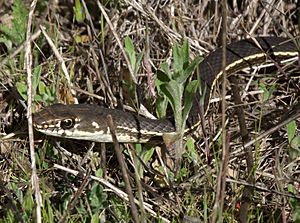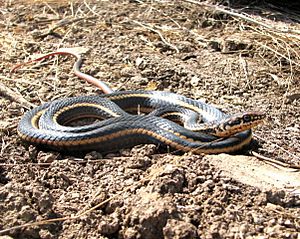California whipsnake facts for kids
Quick facts for kids California whipsnake |
|
|---|---|
 |
|
| Masticophis lateralis lateralis, chaparral whipsnake subspecies |
|
| Conservation status | |
| Scientific classification | |
| Genus: |
Masticophis
|
| Species: |
lateralis
|
| Synonyms | |
The California whipsnake (Masticophis lateralis), also known as the striped racer, is a type of colubrid snake. These snakes live in California in many different places. You can find them near the coast, in deserts, and in hilly areas.
Contents
What Does the California Whipsake Look Like?
The California whipsnake is a long, thin snake. It usually grows to be about 3 to 4 feet (90 to 120 cm) long. It has a dark brown or black back. Along each side, it has a bright yellowish stripe. This stripe helps it blend in with its surroundings.
What Do California Whipsnakes Eat?
California whipsnakes are good hunters. They eat many different live animals. Their diet includes insects, lizards, and even other snakes. They also hunt birds and small mammals. They especially love to eat lizards. The snake catches its prey with its mouth and swallows it whole.
How Do California Whipsnakes Behave?
California whipsnakes are very fast. They are active during the day, which means they are diurnal. They are always on the move, looking for food. These snakes often move through bushes and trees. This helps them avoid predators and catch their prey.
Sometimes, they climb to the top of plants in the morning. They do this to warm up in the sun before the ground gets warm. California whipsnakes are not venomous. However, they might strike if someone tries to catch them.
California Whipsnake Subspecies
The California whipsnake has two main types, called subspecies. These are like different versions of the same snake.
- Chaparral Whipsake (M. l. lateralis)
- The chaparral whipsnake is common in California. It is also found in northern Baja California, Mexico. This subspecies likes areas with different types of plants and landscapes. You can find it from northern to southern California and into Mexico.
- Alameda Whipsake (M. l. euryxanthus)
- The Alameda whipsnake lives only in California. It is considered a threatened species. This means its numbers are low and it needs protection. Its home range is quite small. Many of its habitats are being lost due to new buildings.
- The Alameda whipsnake has a wide head and large eyes. It is black and orange with a yellow stripe on each side. It also has a slender neck. This snake is very quick and good at climbing. It uses its speed to escape danger and catch food.
Where Do California Whipsnakes Live?
The California whipsnake lives in many different places. These include open deserts and oak woodlands. They also live in pine forests and chaparral areas. They like open spaces within these habitats.
The Alameda whipsnake subspecies lives in a specific area. This area includes parts of southern Alameda County. It also covers northern Santa Clara County and western San Joaquin County. These areas are in the southeastern part of Northern California's Bay Area. This subspecies is often found in chaparral and scrub plant communities.
The chaparral whipsnake subspecies lives in woodlands and grasslands. It also likes chaparral scrublands and areas near rivers, called riparian habitats.



